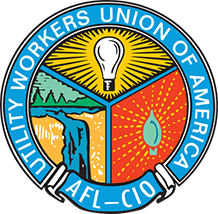The UWUA is setting a new standard for workplace safety by empowering its locals with the tools, training, and contract language needed to take a proactive role in safety advocacy. Whether it’s developing standout local programs or partnering with national resources like the Power for America Training Trust (P4A), the union is placing safety at the center of its mission.
With OSHA’s federal presence receding, the urgency for union safety leadership has never been more critical. Who better to protect our members than the subject matter experts on the front lines — our own union brothers and sisters.
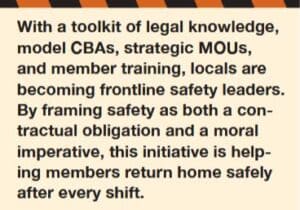
At the heart of UWUA’s safety campaign is a strategic partnership between our National Safety Committee and P4A. Together, they’ve developed a comprehensive approach that locals can adopt to strengthen safety language in collective bargaining agreements (CBAs), institutionalize joint labor-management oversight, and provide members with real authority in shaping safety practices.
The initiative includes:
- Model contract language promoting union-led safety oversight, peer-to-peer education, and just culture principles.
- Using training resources developed by the Labor Occupational Health Program at UC Berkeley to help local leaders negotiate strong safety provisions, activate member support, and effectively use incident data and personal narratives.
- A model Memorandum of Understanding (MOU) for integrating P4A’s Systems of Safety and Safety Leadership programs into employer-run Safety Management Systems (SMS).
This union-led safety framework isn’t just a best practice — it’s becoming a standard that makes safety a contractual right and a daily reality for workers across the country. “Bargaining worker safety and joint safety committees is one of the best ways to protect our members,” says P4A Executive Director Jonathan Harmon.
With a toolkit of legal knowledge, model CBAs, strategic MOUs, and member training, locals are becoming frontline safety leaders. By framing safety as both a contractual obligation and a moral imperative, this initiative is helping members return home safely after every shift.
Real change happens when national strategy meets local action. Across the country, UWUA locals are embracing the union’s call to lead on safety — and the results speak for themselves.
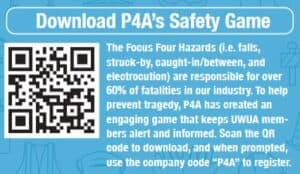
This and the success stories that follow demonstrate what’s possible when locals take ownership of safety. Whether you’re just getting started or looking to expand your program, resources are available. To learn more or get support, contact National Safety Director John “Scotty” MacNeill (john.macneill@uwua.net) and/or P4A’s Jon Harmon (jharmon@power4america.org). Let’s build a future where every UWUA member works with confidence — and returns home safe.
SPOTLIGHT: Local 601 — Slow Speed Driving Course
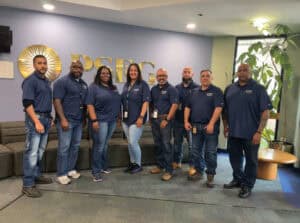
Local 601 launched its Slow Speed Driving Course in response to hazards posed by driving on the job.
When Denise Harris-Hooker, Local 601’s Union Health and Safety Representative and a member of the UWUA National Safety Committee, talks about the Customer Care Slow Speed Driving Course, her pride is unmistakable. “It’s a really good course, and we see the impact in the data,” she says. “Since its launch, motor vehicle incidents have dropped significantly, particularly at-fault accidents in the months following the course,” adds Mark Auriemma, the local’s safety chair.
The course was developed through a collaboration between union and management at Public Service Electric and Gas (PSE&G), Local 601’s largest employer. A logistics team —comprising union representatives Mike Garcia, Mark Auriemma, and Joe Arroyo, alongside three management counterparts and a management coordinator — created the program in response to rising accident rates among employees who drive for work.
Meter readers and field collectors often operate in dense, urban areas like Jersey City and Hoboken. “Motor vehicle accidents are consistently a top safety concern,” says Scotty MacNeill, UWUA’s National Safety Director. “Backup collisions, clipped mirrors, and striking parked cars on narrow streets are real issues. When I mentioned this training on a recent call, everyone wanted details.”
Now in its sixth year, the course has expanded from seven to 12 stations simulating real-world driving challenges — tight spaces, reversing, and parallel parking in urban environments. One station features a child-sized dummy hidden behind a vehicle, reinforcing awareness of unexpected hazards.
Held in parking lots or on college campuses over several weekends, the course is designed for broad participation. Four employees share each vehicle, rotating through all twelve stations. “We begin with a 20-minute safety talk,” Harris-Hooker explains. “We make it clear this isn’t a game — it’s about protecting lives.”
Importantly, the course is not punitive. Observers coach participants, offering tips and second chances. “There’s no stopwatch,” she says. “If someone hits the curb, we guide them through it again with feedback. We want them to leave more confident, not discouraged.”
The program now trains 175 to 280 participants annually and is offered to all union and management field workers who drive on the job — whether in a company vehicle or their own. Training spans multiple weekends, sometimes accommodating up to 82 participants in a single day, including van and box truck drivers.
The initiative has received both national and internal recognition. It was a top 10 finalist for the 2023 National Safety Council’s Green Cross for Safety Advocate Award. The logistics team also received PSE&G’s Victor Dinson Award and the CEO’s Health & Safety Team Award in Honor of Ken Brandt in 2024 — the company’s highest safety distinction.
“Our members have embraced it,” says Harris-Hooker. “We’ve also adapted the course for other departments like gas and construction, tailoring it to different vehicle types.”
The 2025 course, which launched May 31, features a new station on emergency braking, further preparing drivers for unexpected scenarios. “We’re always looking to improve,” she says.
“This kind of training addresses critical needs across all our industries — gas, electric, and water,” adds MacNeill.
Ultimately, the course is a model of union-management collaboration, advancing safety, skills, and culture. “It’s a serious subject, but it’s interactive and fun — and the skills stay with them, both on and off the job,” says Harris-Hooker.
SPOTLIGHT: Local 1-2 — The Art of Safety
Local 1-2’s Art of Safety is a creatively designed program that brings real-world job site scenarios into the classroom. Through storytelling, visual aids, and discussion, the initiative deepens hazard awareness while cultivating a new generation of safety-conscious leaders.

Before Andy Arecco picked up his tools at Consolidated Edison, he wielded an animator’s pen. Eighteen years later, that unique blend of artistry and field experience has sparked a safety movement. Drawing on his background as a Local 1-2 member and a long-time utility worker, Arecco created The Art of Safety — a presentation that challenges corporate safety norms and puts workers at the center of the conversation.
A ConEd veteran and a Union-Management Safety Committee member since 2011, Arecco brings an authentic voice to a space he says is too often driven by top-down mandates. His goal? To move safety culture from clipboard compliance to a people-first approach. “Safety isn’t about numbers — it’s about people,” he says.
Frustrated by generic safety messaging and bureaucratic obstacles, Arecco turned to his creative roots. Before ConEd, he worked as an animator, even dreaming of a Disney career. “Animation taught me to see sequences and movement differently,” he says. “That helped me realize I could change how I thought about safety, too.” Combining field stories, vivid illustrations, and current safety theory, The Art of Safety delivers a compelling message: real safety grows from understanding, not enforcement.
Arecco’s presentation emerged from a deep disconnect he observed: decisions were being made far from the field, with little worker input. “We become silos,” he explains. “Nobody talks to union guys about the work anymore. That’s where bad decisions start.” His program uses storytelling and art to bridge that gap, drawing inspiration from safety experts like Sidney Dekker, Eric Holden, and Todd Conklin. Dekker’s “Safety Differently” model, which views workers as solutions rather than risks, and Conklin’s focus on learning from everyday work, are central to Arecco’s approach.
Launched in September 2024, the program has reached hundreds of Local 1-2 members across ConEd departments. Arecco has given more than a dozen presentations, refining his message with feedback and evolving challenges. Traditional initiatives like ConEd’s STKY (“Sh*t That’ll Kill You”) campaign, he says, only scratch the surface. “You can’t punish mistakes and expect people to speak up. We need systems that allow us to fail safely.”
The presentation starts with a self-caricature of Arecco in his work gear — immediately setting a tone of relatability. “If you talk to people instead of at them, it makes a difference,” he says. And that difference is being noticed. ConEd’s senior leadership has endorsed the program for broader implementation.
But Arecco emphasizes this isn’t just a ConEd story. “This can work anywhere,” he says. “It’s not about the company — it’s about how we think about safety.” With unions poised to play a greater role amid declining regulatory oversight, The Art of Safety offers a powerful blueprint.
In every talk, Arecco reminds workers that safety starts with them. “We can’t leave it in someone else’s hands,” he says. He highlights real-time field examples and stresses that it’s often the routine tasks — not emergencies — that pose the biggest risks. When safety training is delivered with authenticity, heart, and creativity, people listen — and that can save lives.
SPOTLIGHT: California Water Utility Council (CWUC) — Safety Advocate Program
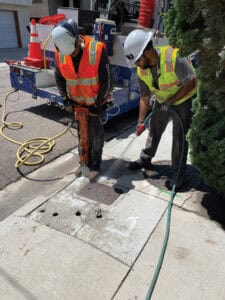
Through contract language that funds both full-time positions and training from the P4A Training Trust, CWUC is transforming workplace safety culture and reducing incident rates across its districts.
The California Water Company (Cal Water) and the California Water Utility Council (CWUC) — a coalition of six UWUA locals representing 665 members across 22 districts — have jointly implemented a groundbreaking Safety Advocate Program that is transforming workplace safety. Launched in 2019 and solidified in the collective bargaining agreement, this innovative initiative funds three full-time safety advocates and includes an annual $140,000 employer contribution to the UWUA’s Power for America (P4A) Training Trust Fund.
Each of the three safety advocates is responsible for 6–8 geographic districts and plays a key role in conducting field audits, developing targeted training programs, and providing peer-to-peer education focused on real-world safety challenges. “The safety advocates bring a regional and company-wide perspective to safety concerns, and they have management’s ear,” says CWUC President Cecil Phillips. The program’s structure ensures that advocates’ concerns are heard and acted upon, giving them what Phillips calls a “formal and weightier role” in shaping company safety policy. As a result, union members gain access to advocates who can directly address their concerns and provide relevant training and support —ranging from safety and skills-based instruction to leadership development.
Scott Carmichael, a member of the UWUA National Safety Committee, was involved from the beginning and served as one of CWUC’s first P4A safety advocates. His early leadership helped lay the foundation for what has become a model safety program. He now serves as a P4A trustee.
One of the current P4A safety advocates, Mike Kunakoff, serves the southern region and plays a vital role in both reactive and proactive safety efforts. His responsibilities include conducting anonymous field audits, attending safety committee meetings, and shaping training content based on field observations. Unlike traditional compliance programs, the safety advocate initiative is non-punitive — its focus is on education and immediate risk mitigation, not discipline.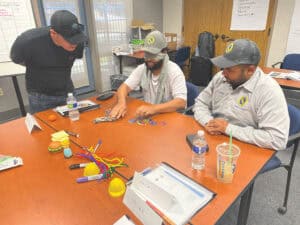
A recent example of the program’s impact is the development of a traffic control training module to address a gap identified among leak truck foremen. Follow-up audits have confirmed adherence to the new standards, and the training has been well received by the workforce. “There’s a cultural shift happening — field crews are more attentive, and communication with management has improved,” says Kunakoff.
The advocates’ work is reviewed regularly by the P4A Steering Committee, which includes both management and local union presidents, ensuring transparency and mutual accountability. Cal Water’s quarterly contributions of $35,000 to the P4A fund further support advanced safety training and help introduce industry best practices to union members.
With advocates spanning multiple districts and maintaining a broad, company-wide perspective, the program enhances coordination between local safety committees and upper management. This structure allows for both localized responsiveness and strategic oversight.
The results speak for themselves: a reduced incident rate and a workforce increasingly engaged in maintaining safe practices. By investing in union-led training and peer-based accountability, Cal Water’s Safety Advocate Program stands as a model for labor-management cooperation — and a benchmark for safety in the utility sector.
